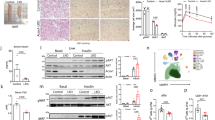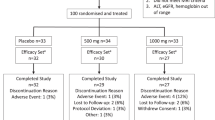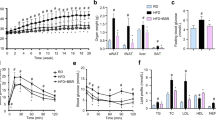Abstract
Berberine8998 is a newly synthesized berberine derivative with better lipid-lowering activity and improved absorption. The objective of this study was to investigate the effects of berberine8998 on serum cholesterol and lipid levels in vivo and to examine the mechanisms involved. Hamsters on high-fat diet (HFD) were administered berberine or berberine8998 (50 mg·kg−1·d−1, ig) for 3 weeks. Berberine8998 administration significantly lowered the total cholesterol, triglycerides and LDL-C levels in HFD hamsters. Bioinformatics revealed that berberine and berberine8998 shared similar metabolic pathways and fatty acid metabolism was the predominant pathway. Western blot validation results showed that peroxisomal acyl-coenzyme A oxidase 1 (ACOX1) and long-chain fatty acid—CoA ligase 1 (ACSL1), two proteins involved in fatty acid metabolism, were expressed differently in the berberine8998 group than in the untreated group and the berberine treatment group. Biochemistry results showed that berberine8998 significantly lowered the non-esterified fatty acid (NEFA) levels, which may lead to a reduction in TG levels in the berberine8998 treatment group and the differences observed in proteomics analyses. Pharmacokinetic analysis conducted in rats. After administration of berberine or berberine8998 (50 mg/kg, ig), berberine8998 exhibited a remarkably improved absorption with increasing bioavailability by 6.7 times compared with berberine. These findings suggest that berberine8998 lowers cholesterol and lipid levels via different mechanisms than berberine, and its improved absorption makes it a promising therapeutic candidate for the treatment of hypercholesterolemia and obesity.
Similar content being viewed by others
Login or create a free account to read this content
Gain free access to this article, as well as selected content from this journal and more on nature.com
or
References
Yin J, Zhang H, Ye J. Traditional chinese medicine in treatment of metabolic syndrome. Endocr Metab Immune Disord Drug Targets 2008; 8: 99–111.
Pirillo A, Catapano AL. Berberine, a plant alkaloid with lipid- and glucose-lowering properties: From in vitro evidence to clinical studies. Atherosclerosis 2015; 243: 449–61.
Kong W, Wei J, Abidi P, Lin M, Inaba S, Li C, et al. Berberine is a novel cholesterol-lowering drug working through a unique mechanism distinct from statins. Nat Med 2004; 10: 1344–51.
Cheng Z, Chen AF, Wu F, Sheng L, Zhang HK, Gu M, et al. 8,8-Dimethyldihydroberberine with improved bioavailability and oral efficacy on obese and diabetic mouse models. Bioorg Med Chem 2010; 18: 5915–24.
Li YH, Li Y, Yang P, Kong WJ, You XF, Ren G, et al. Design, synthesis, and cholesterol-lowering efficacy for prodrugs of berberrubine. Bioorg Med Chem 2010; 18: 6422–8.
Canto JG, Iskandrian AE. Major risk factors for cardiovascular disease: debunking the "only 50%" myth. JAMA 2003; 290: 947–9.
Rader DJ, Daugherty A. Translating molecular discoveries into new therapies for atherosclerosis. Nature 2008; 451: 904–13.
Libby P, Ridker PM, Hansson GK. Progress and challenges in translating the biology of atherosclerosis. Nature 2011; 473: 317–25.
Li H, Chen W, Zhou Y, Abidi P, Sharpe O, Robinson WH, et al. Identification of mRNA binding proteins that regulate the stability of LDL receptor mRNA through AU-rich elements. J Lipid Res 2009; 50: 820–31.
Defesche JC. Low-density lipoprotein receptor--its structure, function, and mutations. Semin Vasc Med 2004; 4: 5–11.
Fass D, Blacklow S, Kim PS, Berger JM. Molecular basis of familial hypercholesterolaemia from structure of LDL receptor module. Nature 1997; 388: 691–3.
Jeon H, Blacklow SC. Structure and physiologic function of the low-density lipoprotein receptor. Annu Rev Biochem 2005; 74: 535–62.
Zeng J, Deng S, Wang Y, Li P, Tang L, Pang Y. Specific inhibition of Acyl-CoA Oxidase-1 by an acetylenic acid improves hepatic lipid and reactive oxygen species (ROS) metabolism in rats fed a high fat diet. J Biol Chem 2017; 292: 3800–9.
Kristensen LP, Larsen MR, Mickley H, Saaby L, Diederichsen AC, Lambrechtsen J, et al. Plasma proteome profiling of atherosclerotic disease manifestations reveals elevated levels of the cytoskeletal protein vinculin. J Proteomics 2014; 101: 141–53.
Ray S, Reddy PJ, Jain R, Gollapalli K, Moiyadi A, Srivastava S. Proteomic technologies for the identification of disease biomarkers in serum: advances and challenges ahead. Proteomics 2011; 11: 2139–61.
Zhang Y, Li X, Zou D, Liu W, Yang J, Zhu N, et al. Treatment of type 2 diabetes and dyslipidemia with the natural plant alkaloid berberine. J Clin Endocrinol Metab 2008; 93: 2559–65.
Chou HC, Lu YC, Cheng CS, Chen YW, Lyu PC, Lin CW, et al. Proteomic and redox-proteomic analysis of berberine-induced cytotoxicity in breast cancer cells. J Proteomics 2012; 75: 3158–76.
Hou Q, Tan HT, Lim KH, Lim TK, Khoo A, Tan IB, et al. Identification and functional validation of caldesmon as a potential gastric cancer metastasis-associated protein. J Proteome Res 2013; 12: 980–90.
Acknowledgements
This work was supported by a grant from Xuhui Central Hospital, Shanghai Clinical Center and the Chinese Academy of Sciences (Shanghai, China) through support for Science and Technology Commission of Shanghai Municipality by the Foundation under grant 10431903400. This work was also supported by a grant from the Shanghai Municipal Commission of Health and Family Planning by the Foundation under grant ZK2012A39.
Author information
Authors and Affiliations
Corresponding authors
Rights and permissions
About this article
Cite this article
Yu, Cy., Liu, Gy., Liu, Xh. et al. Proteomics analysis reveals a potential new target protein for the lipid-lowering effect of Berberine8998. Acta Pharmacol Sin 39, 1473–1482 (2018). https://doi.org/10.1038/aps.2017.200
Received:
Accepted:
Published:
Issue Date:
DOI: https://doi.org/10.1038/aps.2017.200



